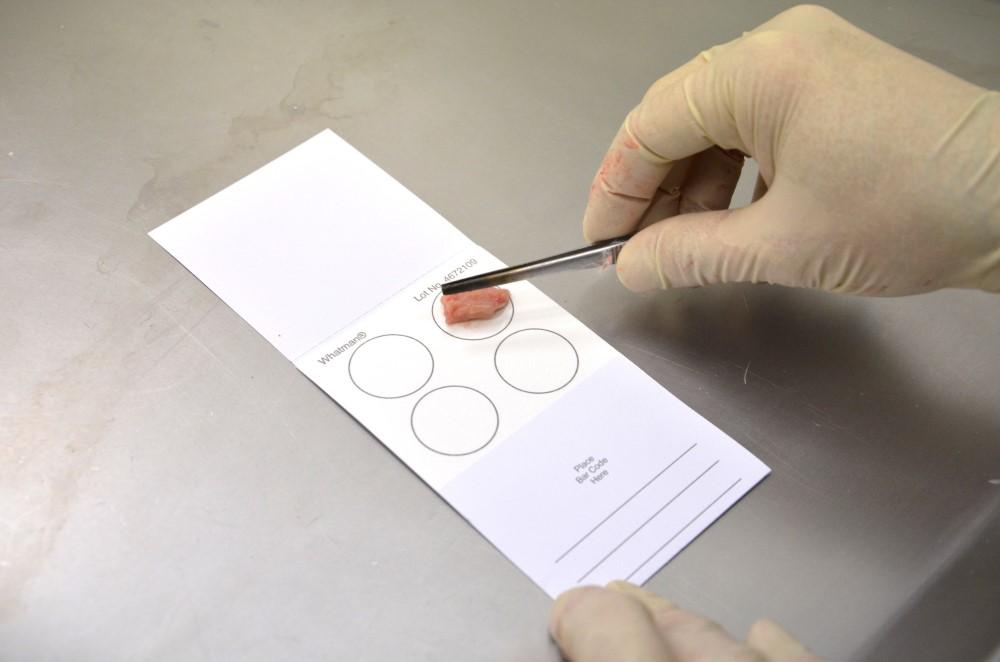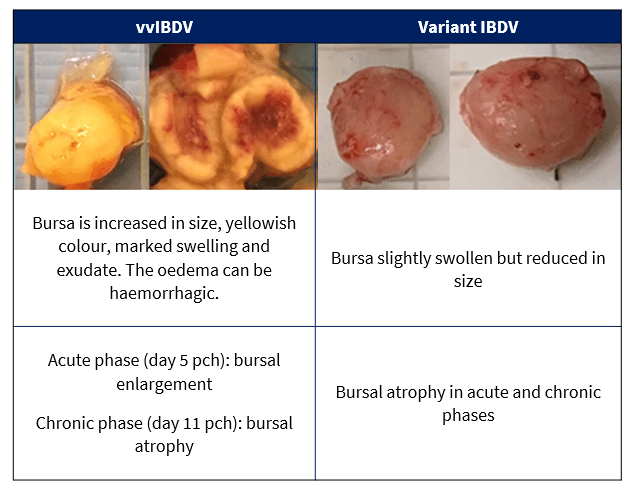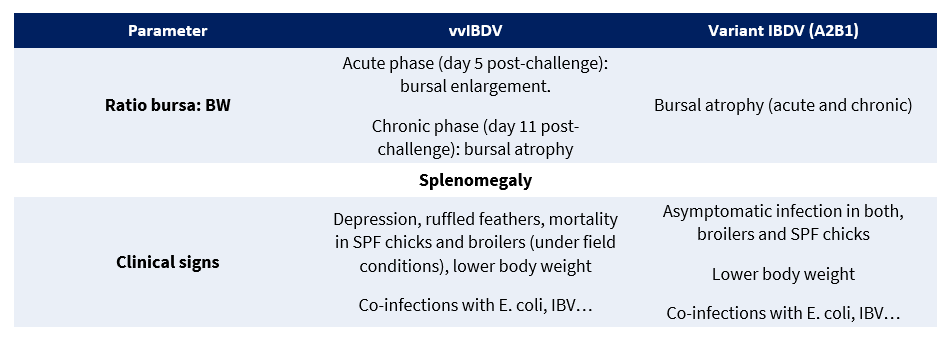Classification of Gumboro disease (IBDV) became more complex with the discovery of antigenic variant strains (avIBDV) in America and a highly virulent strain (vvIBDV) identified in Europe. More detailed information on the antigenicity, pathogenicity and molecular structure of new IBDV isolates made it clear that the descriptive nomenclature used for IBDV was inadequate. Thus, a new nomenclature that includes a genotyping system (G) was proposed1. In this new nomenclature, viruses belonging to the avIBDV group were classified into Genogroups G2, G4, G5, G6, and G71.

While vvIBDV strains have always been associated with high mortality rates (>30%) and visible clinical signs, IBD variant viruses are normally associated more with subclinical forms of Gumboro. Numerous publications have described the huge impact the subclinical form of Gumboro has had on large farms in America and, more recently, in Asia, especially due to the circulation of Gumboro variant G2 viruses.
Therefore, what is the impact of Gumboro variant strains in the poultry industry?
1. Pathogenic impact:
Although mortality is not generally associated with the circulation of G2 strains on farms, their presence in the bursa of Fabricius is normally linked to severe atrophy (Fig. 1) of this important immune organ of chickens, which results in severe immunosuppression and a drop in production performance.

Gumboro variant G2 viruses often show a significantly lower level and shorter duration of in vivo replication and fewer visible lesions compared with the vvIBDV (Li et al., 2023). The difference in the in vivo replication efficiency of the IBD variant vs vvIBDV probably has an important influence on the difference in the pathogenicity of those two types of viruses.
However, like vvIBDV, variants are still able to replicate rapidly in the bursa and to be excreted externally, which could also explain why G2 IBDV do not cause high mortality in chickens but become one of the dominant epidemic strains in many countries. Like vvIBDV in the chronic phase (Table 1), G2 IBDV can cause serious damage to the central immune organ, the bursa of Fabricius, due to a large amount of necrosis and disintegration of B lymphocytes, which explains the severe immunosuppression linked to these viruses.

2. Economic impact:
Variant G2 IBDV has been reported as an economically significant disease because it induces severe bursal damage, profound immunosuppression and subclinical infections that are often the underlying cause of respiratory and enteric diseases in chickens, as well as being the cause of vaccination failures (Icard et al., 2008; Jackwood and Sommer-Wagner, 2005; Perozo et al., 2009). In many cases, the magnitude of the economic losses generated by IBDV strains is difficult to appreciate because immunosuppression often goes unnoticed.
A 5-year study demonstrated that variant IBDV has had a serious influence on the Canadian economy and that it is associated with immunosuppression (Zachar et al., 2016). Variant IBDV is also a potential threat to antibiotic-free chicken farming and is not amenable to the current anti-IBDV vaccination strategy (Kurukulsuriya et al., 2016).
Role of vaccines in combatting the circulation of Gumboro variant strains:
It has been proved that variant G2 IBDV strains in neonatal chickens can evade the maternal antibodies that are produced by broiler breeders immunized with standard or classic IBDV strain vaccines, which leads to severe bursal damage soon after hatching (Icard et al., 2008; Jackwood and Sommer-Wagner, 2005). In those cases, immunosuppression induced by Gumboro variant strains is greatest and permanent because the damaged bursa is not able to regenerate and have a normal immune function.
Similarly, Fan et al. (2019) verified that a novel G2 variant IBDV isolated in China could severely damage the bursa of Fabricius of immunized chickens in the presence of antibodies induced by different types of vaccines against vvIBDV. Monoclonal antibody reactivity patterns and cross-neutralization assays further confirmed the obvious antigenic mismatch between novel Gumboro variant and vvIBDV.
In contrast, Jackwood in 2011 proved that mortality, severity of clinical signs and macroscopic lesions caused by vvIBDV in SPF birds were reduced when Gumboro variant strains were given at intervals of different numbers of days or simultaneously with the vvIBDV. This principle of competitive exclusion in the competition for the bursa of Fabricius niche between two field IBDV, can also be applied between a vaccine virus and a field virus.
In the current scenario of continuous emergence of new variant strains worldwide, the use of live vaccines with good competitive exclusion capacity might be the most powerful solution.
Bibliography
1. Fan L, Wu T, Wang Y, Hussain A, Jiang N, Gao L, Li K, Gao Y, Liu C, Cui H, Pan Q, Zhang Y, Wang X, Qi X, 2019. Novel Variants of Infectious Bursal Disease Virus Can Severely Damage the Bursa of Fabricius of Immunized Chickens, Veterinary Microbiology (2019), doi: https://doi.org/10.1016/j.vetmic.2019.108507
2. Hou B, Wang C-Y, Luo Z-B, Shao G-Q. 2022. Commercial vaccines used in China do not protect against a novel infectious bursal disease virus variant isolated in Fujian. Vet Rec. 2022;e1840.https://doi.org/10.1002/ vetr.1840
3. Icard AH, Sellers HS, Mundt E. 2008. Detection of infectious bursal disease virus isolates with unknown antigenic properties by reverse genetics. Avian Diseases 2008;52:590–598
4. Jackwood DJ, Sommer-Wagner SE. 2005. Molecular epidemiology of infectious bursal disease viruses: Distribution and genetic analysis of newly emerging viruses in the United States. Avian Diseases 2005;49:220–226
5. Jackwood DJ . 2011. Viral Competition and Maternal Immunity Influence the Clinical Disease Caused by Very Virulent Infectious Bursal Disease Virus. Avian Diseases 55:398–406, 2011
6. Kurukulsuriya, S., Ahmed, K.A., Ojkic, D., Gunawardana, T., Gupta, A., Goonewardene, K., Karunaratne, R., Popowich, S., Willson, P., Tikoo, S.K., Gomis, S., 2016. Circulating strains of variant infectious bursal disease virus may pose a challenge for antibiotic-free chicken farming in Canada. Res.Vet. Sci. 108, 54-59
7. Li, K.; Niu, X.; Jiang, N.; Zhang, W.; Wang, G.; Li, K.; Huang, M.; Gao, Y.; Qi, X.; Wang, X. 2023. Comparative Pathogenicity of Three Strains of Infectious Bursal Disease Virus Closely Related to Poultry Industry. Viruses 2023, 15, 1257
8. Zachar T., Popowich S., Goodhope B., Knezacek T., Ojkic D., Willson P., Ashfaque K., Ahmed, Gomis S. 2016. A 5-year study of the incidence and economic impact of variant infectious bursal disease viruses on broiler production in Saskatchewan, Canada. Can. J. Vet. Res. 80, 255-261
